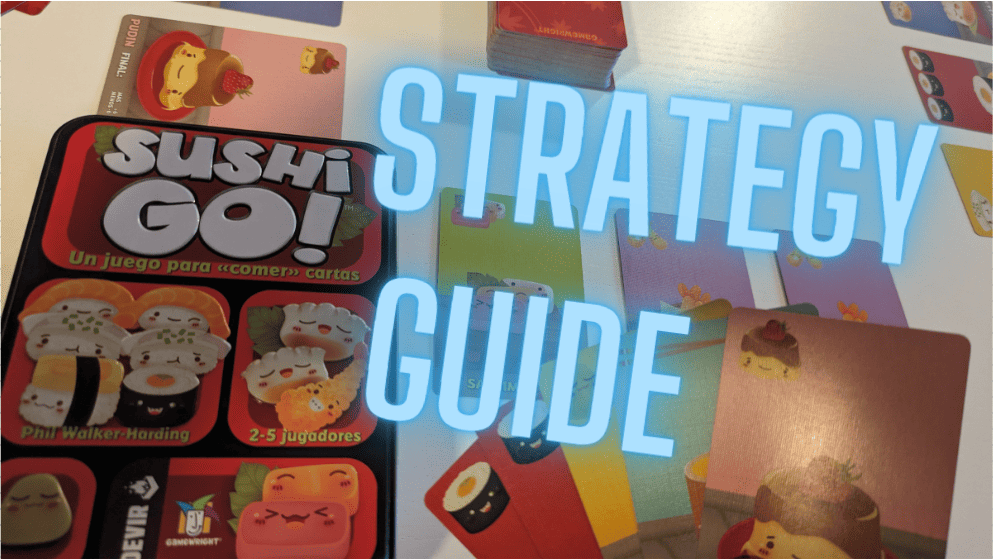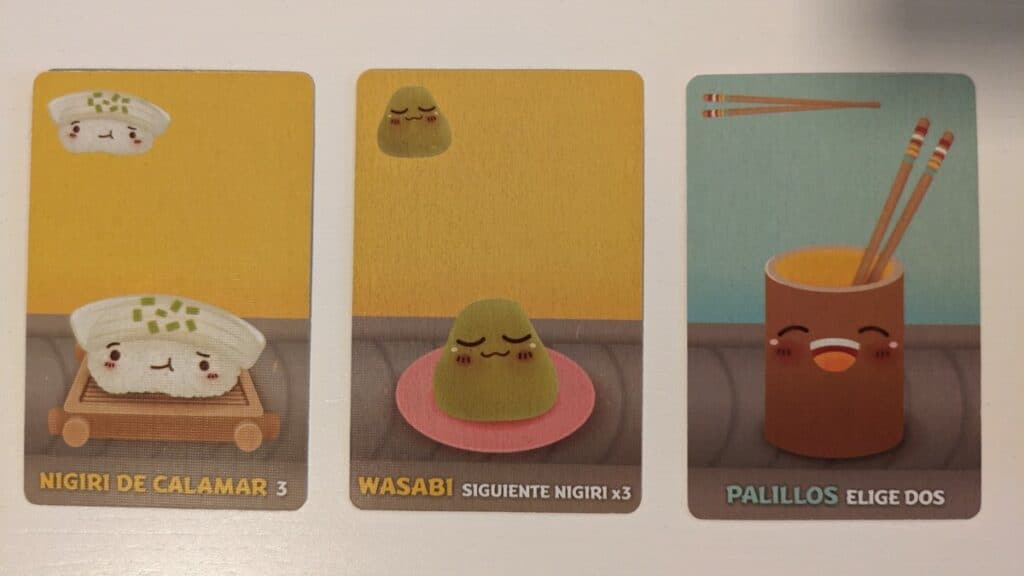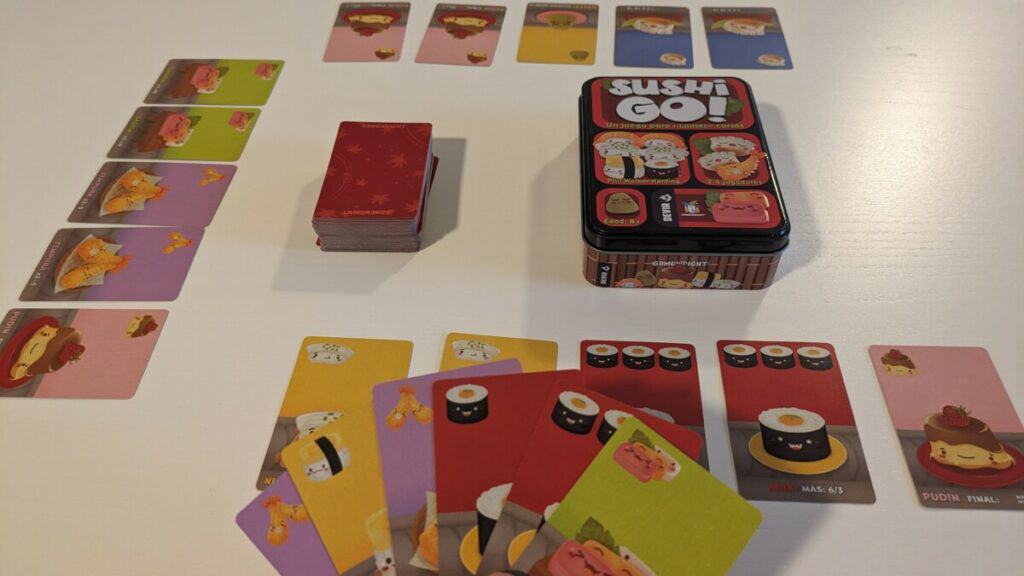
Sushi Go! is a delightful and engaging card game that challenges players to craft the most delicious sushi dishes while strategically outmaneuvering opponents. I’ve played countless games of Sushi Go! both online and with my family and I have developed some simple and effective strategies to win consistently. These Sushi Go! strategies will make you a better player and help you to win more games.
In general, the best Sushi Go! strategies are to play cards that have the most potential value, pace yourself with Pudding cards, and know the distribution of cards in the deck and the current pool. Adjust your play based on what other players do, and deny important cards to your opponents.
On its face, Sushi Go! doesn’t seem like that serious of a game, but once you begin playing you realize how cutthroat and strategic it can be. Every game plays out differently, but I have found that the strategy tips below really helped me to improve my game and win consistently. I’ll go into how and why these strategies work so that you’ll be able to effectively implement them in your own games.
Look for maximum potential value in each card
The most important strategy in Sushi Go! is playing cards with the most potential value. This is easier said than done, and it all starts with understanding the scoring rules and the distribution of cards in the deck. Knowing what cards (and combinations of cards) provide the most potential value will go a long way toward improving your outcomes.
Below is a table of all of the cards in Sushi Go!, the number of each card in the deck, and their potential points per card (PPC). In general, points per card is the most important metric here because it determines the ultimate worth of a card.
| Card | # of Cards in Deck | Max points per card | Min points per card |
|---|---|---|---|
| Wasabi | 6 | 4.5 | 0 |
| Egg Nigiri | 5 | 1.5 | 1 |
| Salmon Nigiri | 10 | 3 | 2 |
| Squid Nigiri | 5 | 4.5 | 3 |
| 3 Maki | 8 | 6 | 0 |
| 2 Maki | 12 | 6 | 0 |
| 1 Maki | 6 | 6 | 0 |
| Dumpling | 14 | 3 | 1 |
| Sashimi | 14 | 3.33 | 0 |
| Tempura | 14 | 2.5 | 0 |
| Chopsticks | 4 | – | – |
| Pudding | 10 | – | – |
The beauty of Sushi Go! is that each of the card types offers a different way to score, with various amounts of risk and upside involved for each. However, we can learn some important takeaways from the above chart.
- Squid Nigiri offer some of the most reliable and high PPC in the game
- Wasabi are extremely valuable when paired with Squid (or even Salmon) Nigiri
- Egg Nigiri are the worst cards in the game
- Maki have the highest potential PPC, but rarely achieve max value
- Sashimi have great PPC but it is difficult to acquire enough of them
- Tempura have decent PPC and are relatively easy to acquire
Chopsticks and Pudding are more difficult to quantify and their value is highly circumstantial, especially in the case of Pudding because they aren’t scored until the final round. Furthermore, every card’s potential value will change as a round is played. Some cards that are usually valuable will become worthless while other cards that are usually undesirable become the best available option.
Understanding the chart above is essential to the rest of these tips. The additional strategies outlined below are all based on this fundamental concept of maximizing the potential value of each card. Once you get a feel for each card’s value and how it changes throughout a round you’ll see a dramatic improvement in your game.
Draw Squid Nigiri, Wasabi, and Chopsticks early

The first two turns of a round are extremely important in Sushi Go! The cards you choose near the beginning of a round can either set up for success or pave the way for failure. In general, you should always play Squid Nigiri, Wasabi, or Chopsticks on your first turn if they’re available. The order of priority should be:
- Squid Nigiri
- Wasabi
- Chopsticks
The best card combination in the game is Wasabi+Squid Nigiri for 9 points (4.5 PPC). Most good players know this, so if one of those two cards is available they’ll almost always play it on their first turn. If given the choice, you should play Squid Nigiri first over Wasabi because the Squid Nigiri gives you a surefire 3 points and it ensures that the player you pass your hand to won’t be able to play the Squid Nigiri on Wasabi.
Play Wasabi first if you don’t have a Squid Nigiri available. If you are passed a Squid Nigiri (or even a Salmon Nigiri) then you can play it on your second turn for 9 (or 6) quick points.
Chopsticks are more difficult to quantify, but their value comes from the flexibility they provide. You can grab combos of cards like Tempura or Wasabi+Nigiri, or even finish a set of Sashimi. Chopsticks are very powerful early in a round, but their value quickly diminishes after the first 3 or 4 rounds because all of the best cards are usually scooped up by then.
Pace yourself with Puddings
Pudding is one of the trickiest (and most entertaining) mechanics in Sushi Go! because it spans all three rounds. In general, you should try to draw at least one Pudding per round. This is almost always enough to ensure that you won’t be last in Puddings and is sometimes enough to put you in position to compete for the most.
CHECK IT OUT: If you like Sushi Go! you’ll also enjoy Sleeping Queens (link to Amazon), another quick & fun family card game from Gamewright. I have a quick-start guide here and, as always, a Complete Strategy Guide to Sleeping Queens.
Exactly how many Puddings you should play is highly situational, but a good starting point is to always ensure that you aren’t last. It’s very difficult to win a game with those -6 points, so avoiding that penalty should be a priority.
It’s perhaps equally important not to hoard a lot more Puddings than anyone else. You can’t be more in first place with Puddings, so having 3 more Puddings than anyone else does you no more good than having 1 more. Those extra Puddings could have been other cards that score you additional points.
Play Pudding when nothing else fits your plan
I try not to make Puddings a priority, but I always take them into consideration when they’re available. I find that the best time to play Pudding is when no other cards in the hand fit into my current plan for the round.

For example, if I’ve played a Wasabi, Nigiri, and Tempura on my first 3 rounds and the next hand doesn’t have a Tempura or something immediately valuable (like Squid Nigiri or Chopsticks) then I would take a Pudding, if available. I haven’t yet committed to anything else, so playing a Pudding is a great way to build some value.
Adjust your strategy to the number of players
The number of players in a game of Sushi Go! tells you a lot about how you should approach the game. Playing a 2-player game (not recommended, but doable) is much different than playing with 4 or 5 because the number of cards in each hand varies and the competition is more direct.
If you’re playing with just 2 players you should be much more defensive with your strategy. For example, pay close attention to the cards they’re drafting and make sure they don’t collect full sets of Sashimi. Drafting a Sashimi that you don’t need to prevent them from scoring 10 points is a net win for you, even if you don’t need the Sashimi yourself.
Playing with 3 to 5 players is much different. Every defensive action you take against the player to your left comes at a cost unless it also helps you because the other players will be gaining ground while you’re spending a turn defending against another player. In general, you should focus on scoring points for yourself in 3 to 5-player games, with defense only a secondary consideration.
Deny your opponents the valuable cards they need
This defensive concept of playing cards that your opponent(s) need is often referred to as ‘hate drafting’. The term is especially applicable when you have no need for the card yourself – the only reason you drafted it was to prevent your opponent from scoring points. This strategy frustrates opponents and it should absolutely be a part of your strategic repertoire.

Many players make the mistake of treating Sushi Go! as a sort of multiplayer solitaire. If you want to win, you have to pay attention to what other players are doing! If you’re having a hard time choosing between 2 or 3 cards to draft, look at your opponent(s) and take the card that you think would be most likely to help them.
Watch your opponents and adjust as needed
Denying important cards to your opponents isn’t the only reason you should be paying attention to their hand. You should be adjusting your strategy on the fly as other players play their cards. This will tell you a lot about the cards they plan to draft and what cards are more likely to be passed to you.
Pay particular attention to the play from whom you’ll be receiving cards (the player on your right, unless you’re playing a rules variant). You want to avoid targeting the same cards as that player because they’ll be able to draft them before you. For example, if you see the player to your right play a Sashimi, you shouldn’t play one yourself because they’ll snatch all the Sashimi up before you get the chance.
Similarly, if you notice that a couple of players have already played Dumplings then you should probably avoid doing so yourself. Dumplings will be in high demand so you might be better off focusing your efforts on cards like Tempura or Maki.
Avoid going for Sashimi against good players
When I first started playing Sushi Go!, I was always very tempted to go for Sashimi. The allure of 10 points (at 3.33 PPC) was too high to ignore so I tried it almost every round. While I did sometimes succeed, I quickly discovered that good players thwarted my attempts almost every time. This became more and more commonplace as I advanced through the ranks in competitive online play.
It’s usually very easy to prevent another player from getting 3 Sashami if you’re paying attention. When you’re playing with advanced/experienced players you should almost never waste turns with Sashimi unless you have some Chopsticks at the ready and you’re confident there will be enough Sashimi available to you.
Know what’s left in the card pool
The most powerful (and difficult) skill you can develop in Sushi Go! is memorizing the cards that are left in the current card pool (that is, to say, all of the cards in each hand). Most casual players don’t have the skill or desire to put this much effort into the game, but if you want to gain a competitive edge you should make some effort to do this.
It’s really not necessary to memorize every card in the pool. Gaining an advantage can be as easy as remembering how many total Puddings or Tempura are available. Choose 1 or 2 specific card types to track and you’ll quickly see that you can keep track of more than you might have thought possible.
Count important cards like Wasabi and Pudding
You should also try to keep track of how many Puddings, Wasabi, and Squid are left in the total deck. Remember, the total deck has:
- 10 Pudding
- 6 Wasabi
- 5 Squid Nigiri
If you keep track of these three card types throughout the game you’ll have a huge advantage. For example, if you’re in a 3-player game and each player has 3 Puddings going into the final round, you know that you should immediately draft the 10th Pudding if you can. Similarly, if you know that all 5 Squid Nigiri have already been played then you know the potential value of Wasabi goes down since, at best, it will be paired with Salmon Nigir for 6 total points (3 PPC).
Get maximum value from using your Chopsticks
I touched on this earlier, but using Chopsticks effectively is an important skill to learn. Being able to draft 2 cards at once from the same hand gives you a lot of flexibility and it makes it more difficult for other players to block you.

Try to use your Chopsticks early in a hand to draft powerful combinations of cards like:
- Two Tempura (2.5 PPC)
- Wasabi + Squid or Salmon Nigiri (4.5 or 3 PPC)
- Two Sashimi (potential 3.33 PPC)
- Two 3-Maki (potential 3 PPC)
Claim 3 Maki early to win more Maki points
Maki are perhaps the most difficult cards to manage in a round of Sushi Go! because you’re in direct competition with other players for the same pool of points. In my experience, most players tend to leave Maki as some of the last cards they target. This means that the last few hands of a round are often just every player drafting the highest Maki cards left in their hands.
Try drafting a 3-Maki card in the middle of a round to put you at an advantage. This is especially powerful when there aren’t many total Maki in the round’s card pool, but it’s almost always a solid choice. Maki cards have to go to someone, so it’s always nice to make sure that you have a 3-Maki to start with. Just try to avoid getting in an early Maki race with another player – usually, it’s best to live with second-place Maki points and try to score points elsewhere.
Thanks for reading! If I missed something or you have your own opinions, please drop a comment below.
What is thr benefit of along out first in hand? Seems to me like you would never want to assume…
Your strategy comments are excellent, well thought out and very helpful! Thank you
You would only get to draw and play a Sanctuary card on turn two of round one if the Region…
Rule question. If in phase one of round one I play a Region card with a Clue symbol at the…

Leave a Reply